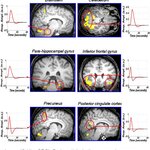Neuroscience

The rapidity of ejaculation in men is genetically determined, according to research by Utrecht University Neuropsychiatrist Dr. Marcel Waldinger and Pharmacological Researcher Paddy Janssen.
The participants in the study by Waldinger and Janssen were 89 Dutch men who suffer from the primary form of premature ejaculation, in other words, men who always had this problem. A control group of 92 men was also studied. For a month the female partners used a stopwatch at home to measure the time until ejaculation each time they had intercourse.
In men who suffer from premature ejaculation, the…

Sleep in man is divided in two main phases : non-REM sleep, which occupies most of our early sleep night, and REM sleep, during which our dreams prevail. Non-REM sleep is usually considered as a compensatory ‘resting’ state for the brain, following the intense waking brain activity. Indeed, previous brain imaging studies showed that the brain was less active during periods of non-REM sleep as compared to periods of wakefulness.
Although not rejecting this concept, researchers from the Cyclotron Research Centre of the University of Liège in Belgium and from the Department of Neurology of Liege…

Scientists have used a technique originally developed for economic study, Granger causality, to become the first to overcome a significant challenge in brain research: determining the flow of information from one part of the brain to another.
For years, scientists have used scanners to identify the brain regions involved in particular mental tasks. But they cannot get that data fast enough to trace the flow of information from one area of the brain to another.
"It's been like getting a picture of the members of an orchestra but not knowing the sequence in which each instrument was playing,"…

Babies make sense of the world long before they can talk, says Brigham Young University psychology professor and study author Ross Flom. Their new study shows that even babies as young as five months can distinguish an upbeat tune, like Beethoven’s “Ode to Joy” from the Ninth Symphony, from gloomier compositions like that minor key stuff by Chopin(1).
By age nine months, babies can also do the opposite and pick out the sorrowful sound of Beethoven’s Seventh Symphony from a pack of happy pieces.
“One of the first things babies understand communicatively is emotion, so for them the melody is…

Eating too many calories throws critical portions of the brain out of whack, reveals a study in the journal Cell. That response in the brain's hypothalamus — the "headquarters" for maintaining energy balance — can happen even in the absence of any weight gain, according to new studies done in mice.
The brain response involves a molecular player, called IKKß/NF-?B, which is known to drive metabolic inflammation in other body tissues. The discovery suggests that treatments designed to block this pathway in the brain might fight the ever-increasing spread of obesity and related diseases,…

There's a lot of truth in the old proverb "experience is the best teacher," and apparently it even applies to 10-month-old infants.
Researchers have found that infants who had an opportunity to use a plastic cane to get an out-of-reach toy were better able to understand the goal of another person's use of a similar tool than were infants who had previously only watched an adult use a cane to retrieve a toy.
"Acting on the world is one way infants learn about the world, and only recently have there been studies showing that active, hands-on experience is a more effective way of learning than…

Religious emotions and beliefs have often been linked to a capacity to deal with pain, as those
images of Philippine men being willingly crucified during religious festivals so well demonstrates. But although changes in pain sensitivity during a religious experience are well documented, the exact psychological or/and neurological reasons of the phenomenon are unclear and, as such, have now become the aim of an investigation by a group of scientists, philosophers and psychologists from the University of Oxford.
The research, to be published in the next edition of the journal Pain, reveals…

For decades now, cigarette makers have marketed light cigarettes, which contain less nicotine than regular smokes, with the implication that they are less harmful to smokers' health. A new UCLA study shows, however, that they deliver nearly as much nicotine to the brain.
The basic numbers would seem to bear that out the less harmful claim. Light cigarettes have nicotine levels of 0.6 to 1 milligrams, while regular cigarettes contain between 1.2 and 1.4 milligrams.
In the brain, nicotine binds to specific molecules on nerve cells called nicotinic acetylcholine receptors, or nAChRs.…

Scientists at Yale School of Medicine have found that two-year-olds with autism looked significantly more at the mouths of others, and less at their eyes, than typically developing toddlers. This abnormality predicts the level of disability, according to study results published in the Archives of General Psychiatry.
Lead author Warren Jones and colleagues Ami Klin and Fred Volkmar used eye-tracking technology to quantify the visual fixations of two-year-olds who watched caregivers approach them and engage in typical mother-child interactions, such as playing games like peek-a-boo.
After the…

Eight-year-old children have a much different learning strategy compared to twelve-year-olds and adults. Eight-year-olds learn primarily from positive feedback ('Well done!'), whereas negative feedback ('Got it wrong this time') scarcely causes any alarm bells to ring. Twelve-year-olds are better able to process negative feedback and learn from their mistakes. Adults do the same, but even more efficiently.
The switch in learning strategy has been demonstrated in behavioral research, which shows that eight-year-olds respond disproportionately inaccurately to negative feedback. But the switch…